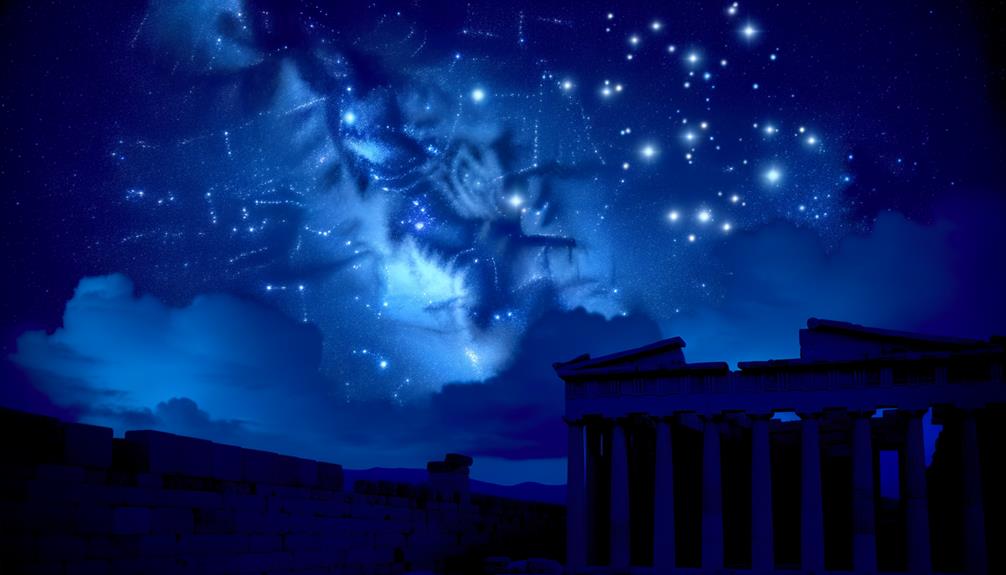Meaning of the Name Cassiopeia
Cassiopeia, originating in Greek mythology, is attributed to a queen known for her vanity. It is also a prominent constellation in the northern sky, recognized by its distinctive 'W' shape.
The constellation boasts significant deep-sky objects and notable stars such as Schedar and Caph. Cassiopeia's influence extends to literature, symbolizing themes of vanity and punishment, and is a frequent subject in varied artistic representations.
In modern culture, Cassiopeia remains pivotal in astronomy, education, and technological advancements, like the naming of spacecraft. To uncover the intricate details and diverse impact of Cassiopeia, one can explore further.

Key Takeaways
- The name Cassiopeia originates from Greek mythology, referring to a queen known for her vanity.
- Cassiopeia is the name of a prominent constellation in the northern sky, shaped like a 'W'.
- In literature, Cassiopeia symbolizes vanity, punishment, and transformation.
- The name Cassiopeia has inspired a variety of artistic representations, from Renaissance paintings to digital art.
- Cassiopeia holds significant cultural impact, appearing in modern astronomy, popular culture, and educational curricula.
Greek Mythological Origins
Frequently referenced in ancient texts, the name Cassiopeia originates from Greek mythology, where it is attributed to a queen who was the mother of Andromeda. Cassiopeia, wife of King Cepheus of Aethiopia, is renowned for her vanity, boasting that her beauty surpassed that of the Nereids, sea nymphs.
This hubris incited the wrath of Poseidon, leading to a sequence of events involving her daughter Andromeda's near-sacrifice to the sea monster Cetus. In iconography and literature, Cassiopeia is often depicted chained to a chair, symbolizing her punishment.
This mythological narrative encapsulates themes of hubris and divine retribution, offering rich material for the study of ancient Greek cultural values and their influence on subsequent literary and artistic traditions.
Astronomical Significance
Cassiopeia is a prominent constellation in the northern sky, easily recognizable by its distinctive 'W' shape formed by five bright stars. Its astronomical significance is multifaceted, encompassing various aspects:
- Location and Visibility: Cassiopeia is circumpolar for mid to high northern latitudes, meaning it is visible year-round. This makes it an essential reference point for celestial navigation and amateur stargazing.
- Notable Stars: The constellation contains notable stars such as Schedar (Alpha Cassiopeiae) and Caph (Beta Cassiopeiae), both of which serve as key markers for identifying the constellation and understanding stellar classification.
- Deep Sky Objects: Cassiopeia is rich with deep sky objects, including the famous open clusters M52 and NGC 457, which provide valuable data for studying stellar formation and evolution.
Influence in Literature
The constellation of Cassiopeia has exerted a profound influence on literature, serving as a potent symbol and a narrative device in various cultural and historical contexts. Its distinctive W-shaped pattern and mythological backstory, rooted in Greek mythology, provide rich thematic material. Authors often employ Cassiopeia to underscore themes of vanity, punishment, and transformation, drawing from the myth of the Ethiopian queen punished by Poseidon.
In addition, its prominence in the night sky makes it an ideal literary device to evoke wonder, navigation, and the passage of time. Works ranging from classical literature to modern novels frequently utilize Cassiopeia to anchor stories in a celestial framework, thereby enriching narrative complexity and symbolic depth.
Artistic Representations
Beyond its literary significance, the constellation of Cassiopeia has also inspired a myriad of artistic representations, manifesting in diverse mediums such as painting, sculpture, and digital art. These artistic endeavors often explore themes of mythology, celestial beauty, and existential human inquiry.
In particular, three notable representations include:
- Renaissance Paintings: Artists like Titian and Veronese depicted Cassiopeia in classical mythological scenes, emphasizing her regal and tragic dimensions.
- Modern Sculpture: Contemporary sculptors, such as Anish Kapoor, have reimagined Cassiopeia in abstract forms, focusing on the constellation's geometric and spatial properties.
- Digital Art Installations: Digital artists employ cutting-edge technology to create immersive experiences, blending celestial imagery with interactive elements to engage audiences in a dynamic representation of Cassiopeia.
Modern Cultural Impact
A multitude of contemporary cultural narratives and scientific endeavors have integrated the constellation Cassiopeia, reflecting its enduring influence across various domains.
In modern astronomy, Cassiopeia serves as a critical reference point for locating other celestial objects due to its distinctive 'W' shape. Also, it has permeated popular culture, appearing in literature, films, and video games, often symbolizing mystery or nobility.
The constellation has also inspired technological advancements; for instance, the Cassiopeia spacecraft, launched by private aerospace companies, underscores its significance in space exploration.
Moreover, Cassiopeia is frequently utilized in educational curricula to teach stellar navigation and mythology, ensuring its legacy persists. These diverse applications highlight Cassiopeia's multifaceted impact on contemporary science and culture.
Conclusion
The name Cassiopeia, deeply rooted in Greek mythology and immortalized in the celestial constellation, continues to exert significant influence across diverse fields such as literature, art, and modern culture.
Importantly, the constellation Cassiopeia contains 157 stars, highlighting its prominence in the night sky.
This enduring legacy underscores the name's pervasive impact, illustrating its capacity to inspire and resonate through various cultural and scientific domains, thereby cementing its place in both historical and contemporary contexts.






